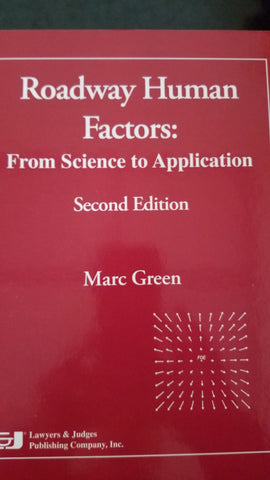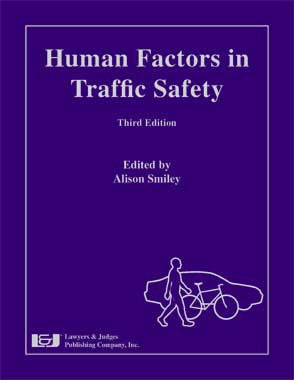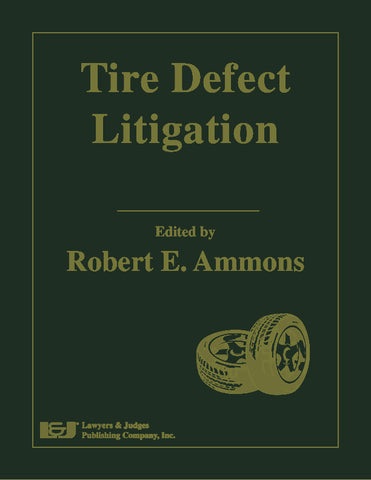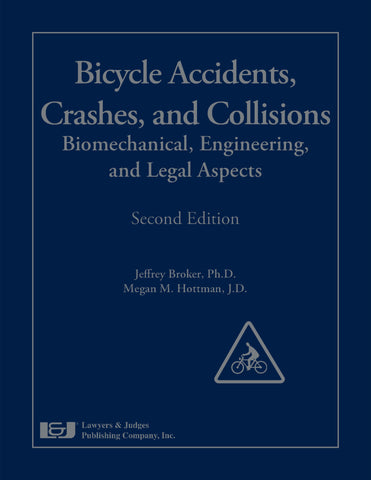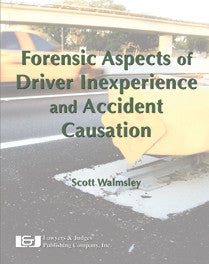
Forensic Aspects of Driver Inexperience & Accident Causation
- Author: Scott Walmsley
- ISBN 10: 1-933264-62-4
- ISBN 13: 978-1933264-62-2
- Copyright Date Ed: August 1, 2011
- Pages: 622
- Binding Information: Casebound
- Size: 8 1/2 ✕ 11 Inches (US)
According to a recent NHTSA study, the 16-20 year old age group accounts for the most injury, property damage, and fatal crashes per driver. To understand why inexperienced drivers are responsible for a significantly disproportionate percentage of collisions, a detailed examination and analysis of multiple traffic scenarios, driving tasks, human behaviors, perceptions and environmental conditions is required.
Forensic Aspects of Driver Inexperience and Accident Causation draws upon the extensive experience of author Scott Walmsley, who as a certified traffic safety educator has conducted over 17,000 on-street instructional sessions with approximately 3,200 new drivers over a period of 16 years. From this extensive experience, Walmsley accurately details the connection between inexperience and collisions. As a certified trainer of instructors, Walmsley is fully accredited by the Washington State Department of Licensing to teach other traffic safety educators how to effectively instruct students in defensive driving techniques, proper visual practices, evasive maneuvers and decisive vehicle control skills.
Walmsley details over 50 skill deficiencies common among inexperienced drivers that increase collision probability, describing how these affect perceptions, judgments, behaviors, reactions, decisions, and actions. From this information, the reader learns how particular skill deficiencies associated with inexperience combine with specific traffic scenarios and result in critical driving errors. All of these errors occurred with frequency and predictability across the range of inexperienced drivers, giving the reader insight into the human factors that are statistically common among inexperienced drivers.
This book also discusses the emotional and perceptual factors involved in errors among inexperienced drivers. Fear, impatience, aggressiveness, and a sense of entitlement can supplant the logical thought process, thereby increasing errors. Perceptual errors, such as an inability to judge closure rates or gaps in traffic, also lead to specific miscalculations in younger or inexperienced drivers. Most importantly, this book discusses how new drivers can remedy these deficiencies and prevent specific collisions.
This highly original book is equally useful to legal professionals, accident reconstructionists, insurance professionals, and driver education instructors, among others. It is a crucial reference text for anyone involved in any capacity with younger or inexperienced drivers, and the crashes that might result from this group. Get your copy today!
This book is also available as an eBook. Click here to purchase and download:
Book topics include:
- Task Execution Process
- Fifty-Two Skill Deficiencies of Driver Inexperience
- Unprotected Left Turn Collisions
- Head-On Collisions
- Crossing the Centerline
- Entering Arterials from Stops
- Collisions Occurring While Entering Traffic from a Curb
- Collisions Occurring on Approach to Intersections Prior to Turns
- Collisions Involving Loss of Vehicle Control on Turns
- Curve-induced Collisions
- Vehicle-Pedestrian Collisions
- Uncontrolled Intersection Collisions
- Vehicle-Bicycle Collisions
- Vehicle-Motorcycle Collisions
- Lane Change Collisions
- Merging Collisions
- Right Turn on Red Collisions
- Left Turn on Red Collisions
- Collisions Occurring During Multiple Lane Turns
- Collisions at All Way Stops
- Rear End Collisions
Table of Contents
Introduction
Chapter 1: The Task Execution Process
Chapter 2: Fifty-Two Skill Deficiencies of Driver Inexperience
Chapter 3A: Unprotected Left Turns: Confusing Protected and Unprotected Left Turns
Chapter 3B: Unprotected Left Turns: Misjudging the Rate of Closure of Approaching Vehicles
Chapter 3C: Unprotected Left Turns: Hitting a Pedestrian in the Left Crosswalk
Chapter 3D: Unprotected Left Turns: Colliding with an Approaching Vehicle from Oncoming Lane 2 while Turning Left Simultaneously with an Opposing Vehicle
Chapter 3E: Unprotected Left Turns: Collision with an Approaching Vehicle from Oncoming Lane 2 with an Opposing Vehicle Obstructing the Sight Line (Blind Unprotected Left Turns)
Chapter 3F: Collision with a Vehicle Making a Right Turn from the Opposing Side of the Intersection
Chapter 3G: Unprotected Left Turns: Failure to Perceive a Vehicle Entering the Body of Oncoming Traffic from an Intersection, Driveway or Curb
Chapter 3H: Unprotected Left Turns: Reacting Incorrectly to a Multi-phase Traffic Signal
Chapter 3I: Unprotected Left Turns: Concluding an Unprotected Left Turn on the Yellow Phase of the Traffic Signal with Oncoming Vehicles Approaching the Intersection
Chapter 3J: Unprotected Left Turns: Holding Improperly Far into the Intersection
Chapter 3K: Unprotected Left Turns: Commencing an Unprotected Left Turn with Insufficient Space in the Destination Lane
Chapter 3L: Unprotected Left Turns: Errantly Executing an Unprotected Left Turn Concurrently with the Forward-Positioned Vehicle
Chapter 3M: Unprotected Left Turns: Commencing an Unprotected Left Turn as the First Opposing Oncoming Vehicle is Stopped
Chapter 4A: Head-On Collisions: Crossing the Centerline as a Result of Incorrect Lane Positioning
Chapter 4B: Head-On Collisions: Failure to Maintain Lane Position During Evasive Maneuvers
Chapter 4C: Head-On Collisions: Crossing the Centerline as a Result of Divergent Errors
Chapter 4D: Head-On Collisions: Collisions Occurring While Passing
Chapter 4E: Head-On Collisions: Collisions Occurring While Entering Traffic from a Stop
Chapter 4F: Head-On Collisions: Collisions Occurring During Left Turns
Chapter 4G: Head-On Collisions: Collisions Transpiring in the Two-Way Left Turn Lane
Chapter 5A: Entering Arterials from Stops: Collisions with Approaching Lateral Vehicles When Entering a Traffic Flow from a Stop (Right Turns)
Chapter 5B: Entering Arterials from Stops: Diverting into Opposing Vehicles when Entering a Traffic Flow from a Stop (Right Turns)
Chapter 5C: Entering Arterials From Stops: Collisions With Vehicles Within The Body Of Cross Traffic (Left Turns Or Advancing Straight)
Chapter 6A: Collisions Occurring While Entering Traffic from a Curb: Colliding with a Vehicle in the Destination Lane
Chapter 6B: Collisions Occurring While Entering Traffic from a Curb: Crossing into Opposing Traffic Resulting in a Head-On Collision
Chapter 7A: Collisions Occurring on Approach to Intersections Prior to Turns: Turning from the Incorrect Lane
Chapter 7B: Collisions Occurring on Approach to Intersections Prior to Turns: Attempting to Enter the Turn Lane at a Hazardous Juncture
Chapter 8A: Collisions Involving Loss of Vehicle Control on Turns: Head-On Collision Due to Crossing of Centerline on Right Turn
Chapter 8B: Collisions Involving Loss of Vehicle Control on Turns: Vehicle Diverts off Road to Right (Right Turn)
Chapter 8C: Collisions Involving Loss of Vehicle Control on Turns: Steering into the Opposing Direction of Traffic on a Left Turn
Chapter 9A: Curve-induced Collisions: Diverting Out of Lane at the Curve Apex (Over Centerline or Running off Road)
Chapter 9B: Curve-induced Collisions: Diverting Out of the Lane at Curve Exit (Over Centerline or Running Off Road)
Chapter 9C: Curve-induced Collisions: Crossing Centerline/Diverting Off the Roadway on Consecutive Transversal Curves
Chapter 9D: Curve-induced Collisions: Vehicle Rollover
Chapter 10A: Vehicle-Pedestrian Collisions: Hitting Pedestrians on the Approach to Stops
Chapter 10B: Vehicle-Pedestrian Collisions: Hitting Pedestrians While Entering Traffic from a Stop
Chapter 10C: Vehicle-Pedestrian Collisions: Hitting Pedestrians in Crosswalk (Where No Stop Sign or Traffic Signal is Present)
Chapter 10D: Vehicle-Pedestrian Collisions: Incidences Occurring While Reversing
Chapter 10E: Vehicle-Pedestrian Collisions: Hitting Pedestrians in Parking Lots and Open Areas
Chapter 10F: Vehicle-Pedestrian Collisions: Hitting Pedestrians in the Right Crosswalk While Exiting Traffic (Right Turns with No Stop Sign or Red Traffic Signal)
Chapter 10G: Vehicle-Pedestrian Collisions: Hitting Pedestrians on Residential Streets (Or Similar Areas) Subsequent to Exiting an Arterial
Chapter 10H: Vehicle-Pedestrian Collisions: Hitting Pedestrians at All Way Stops
Chapter 10I: Vehicle-Pedestrian Collisions: Hitting Pedestrians While Entering Traffic from a Curb
Chapter 10J: Vehicle-Pedestrian Collisions: Hitting Pedestrians Who are Entering/Exiting Vehicles Parked at a Curb
Chapter 10K: Vehicle-Pedestrian Collisions: Hitting Pedestrians on Blind Curves
Chapter 10L: Vehicle-Pedestrian Collisions: Hitting Pedestrians in the Left Crosswalk During a Protected Left Turn
Chapter 11A: Uncontrolled Intersection Collisions: Side Impact Collisions
Chapter 11B: Uncontrolled Intersection Collisions: Head-On Collisions Resulting from Incorrect Travel Path Execution During Left Turns
Chapter 11C: Uncontrolled Intersection Collisions: Head-On Collisions Resulting from Incorrect Travel Path Execution During Right Turns
Chapter 12A: Vehicle-Bicycle Collisions: Hitting a Through Rider by a Vehicle Making a Right Turn
Chapter 12B: Vehicle-Bicycle Collisions: Hitting a Cyclist in the Process of Overtaking
Chapter 12C: Vehicle-Bicycle Collisions: Hitting a Cyclist from the Rear
Chapter 12D: Vehicle-Bicycle Collisions: Hitting a Cyclist While Executing an Unprotected Left Turn
Chapter 12E: Vehicle-Bicycle Collisions: Hitting a Cyclist While Entering Traffic from a Curb
Chapter 13A: Vehicle-Motorcycle Collisions: Hitting a Motorcyclist During a Lane Change
Chapter 13B: Vehicle-Motorcycle Collisions: Hitting a Motorcyclist While Executing an Unprotected Left Turn
Chapter 13C: Vehicle-Motorcycle Collisions: Hitting a Motorcyclist from the Rear
Chapter 14A: Lane Change Collisions: Colliding with a Vehicle in the Destination Lane
Chapter 14B: Lane Change Collisions: Colliding with the Forward-Positioned Vehicle in the Destination Lane
Chapter 14C: Lane Change Collisions: Crossing the Centerline/Diverting Off the Roadway
Chapter 14D: Lane Change Collisions: Colliding with a Vehicle Entering the Destination Lane from Two Lanes Distant (Two Vehicles Converging into a Common Center Lane)
Chapter 14E: Lane Change Collisions: Collisions Resulting from Changes Across Multiple Lanes
Chapter 15A: Merging Collisions: Collisions with Vehicles in the Destination Lane
Chapter 15B: Merging Collisions: Colliding with the Forward-Positioned Vehicle After Merging into the Destination Lane
Chapter 15C: Merging Collisions: Collisions with Vehicles Accelerating from a Ramp Meter
Chapter 15D: Merging Collisions: Merging to an Entrance Ramp from a Ramp Meter
Chapter 15E: Merging Collisions: Entering into the Left Lane of a Freeway
Chapter 15F: Merging Collisions: Merges which Require Crossing Multiple Lanes
Chapter 16A: Right Turn On Red Collisions: Collision with an Opposing Left Turning Vehicle
Chapter 16B: Right Turn on Red Collisions: Hitting Pedestrians in the Right Crosswalk
Chapter 16C: Right Turn on Red Collisions: Hitting Pedestrians in the Forward Crosswalk
Chapter 17A: Left Turn on Red Collisions: Collisions with Oncoming Vehicles When the Traffic Signal Changes to the Green Phase
Chapter 17B: Left Turn on Red Collisions: Hitting Pedestrians in the Left Crosswalk
Chapter 18A: Collisions Occurring During Multiple Lane Turns: Errantly Diverting to the Outside Lane (When Turning from the Inside Lane)
Chapter 18B: Collisions Occurring During Multiple Lane Turns: Diverting into the Inside Lane (When Turning from the Outside Lane)
Chapter 19A: Collisions at All Way Stops: Collisions with Lateral Traveling Vehicles
Chapter 19B: Collisions at All Way Stops: Colliding with an Opposing Left Turning Vehicle that Arrived at the Intersection First
Chapter 20: Rear End Collisions
About the Author
Index

